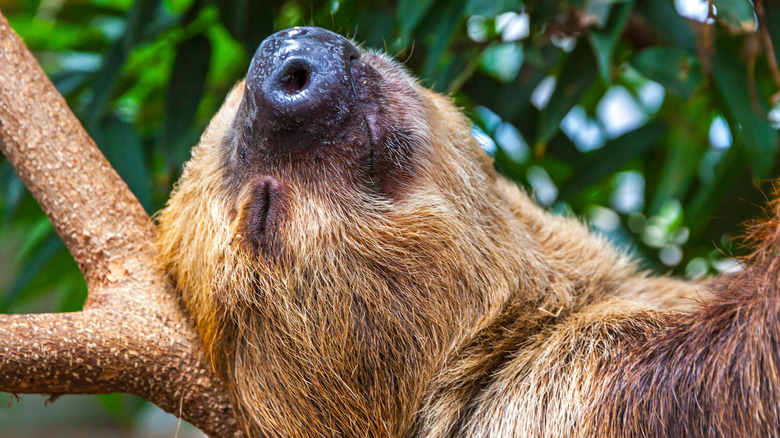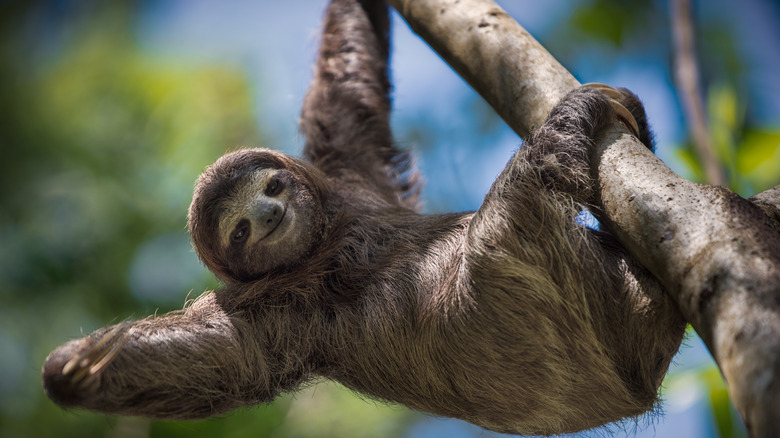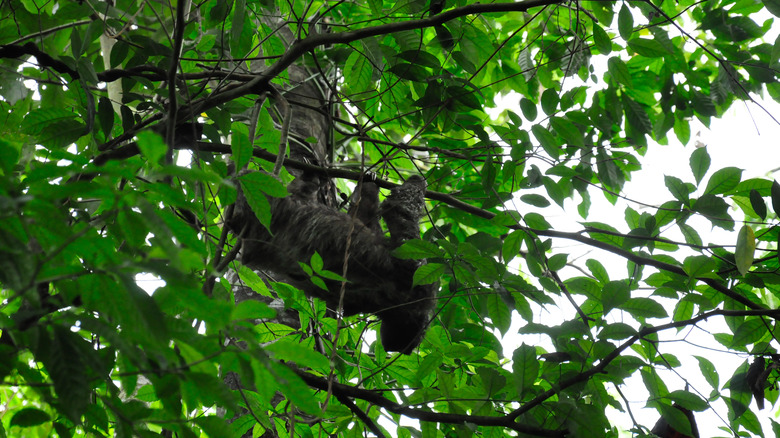How Sloths Are Able To Stay Healthy With Their Lack Of Movement
Kristen Bell was ahead of the pop culture game in 2012 when her then-boyfriend, now-husband Dax Shepard treated her to a surprise visit with her favorite animal, the sloth, and she had an excitement- and joy-fueled meltdown before she had even met the furry angel waiting for her downstairs at her birthday party (it's worth a rewatch on YouTube, it really is). Nowadays, you can acquire any manner of merch bearing the likeness of the very, very long and cuddly-looking creature, including slippers, jewelry, and blanket hoodies, just to name a few.
Sloths weren't always so beloved, but that's because they weren't as studied and relatively understood as they are now. For example, in 1749, French naturalist Georges Buffon was the first to describe them, documenting them thusly (per The Conversation): "Slowness, habitual pain, and stupidity are the results of this strange and bungled conformation. These sloths are the lowest form of existence. One more defect would have made their lives impossible." Thankfully, sloths would by far have the last laugh. But let's address Buffon's assessment of the sloth — its slowness, and alleged chronic health and survival issues. How do sloths stay healthy with their inherent lack of movement?
Adorable evolution
First of all, contrary to one popular belief, sloths do move; it's just that they move very slowly. According to the World Wildlife Federation, sloths travel only about 41 yards per day (that's a bit less than half the football field that your favorite team plays on). They don't need to get their steps in like humans do, because their metabolic rates are so low, their little bodies just plain don't need to.
And their metabolic rates are so low because their body temperature is around 91 degrees, making the need for caloric intake very low indeed, per The Conversation. Their main food sources — leaves, buds, and twigs — are probably based on convenience, seeing as they tend to be found in the same trees that sloths inhabit. As you might guess, these dietary components have very few calories, but because of that low metabolic rate, the sloths don't need any more than that; in fact, it takes them days to process the food, whereas it would take mere hours for us other, warmer-blooded mammals. They take in little energy, they burn very little energy; it's how they're built.
Sweet symbiosis!
"And what about escaping predators?" you might ask. The answer is quite simple: camouflage. BioMed Central explains that sloth fur is hospitable to a wide array of small organisms, notably algae. In particular, trichophilus welckeri, a type of green algae, has formed a symbiotic relationship with sloths, co-evolving with them and providing them with "camouflage and extra nutrients via diffusion and absorption through the hair and skin." In exchange, sloths' multi-textured fur provides the algae with plenty of water and shelter to flourish. So between the sloths' slow, barely-perceptible movement, canopies of tree branches and leaves, and algae, many predators never know they're there. The special algae is passed along from mother sloths to their babies, and the co-evolution continues.
In a nutshell: Sloths stay healthy — slow movement and all — because that's the way they're built. They've been around for about 64 million years, so they're no "bungled conformation," thank you very much.


